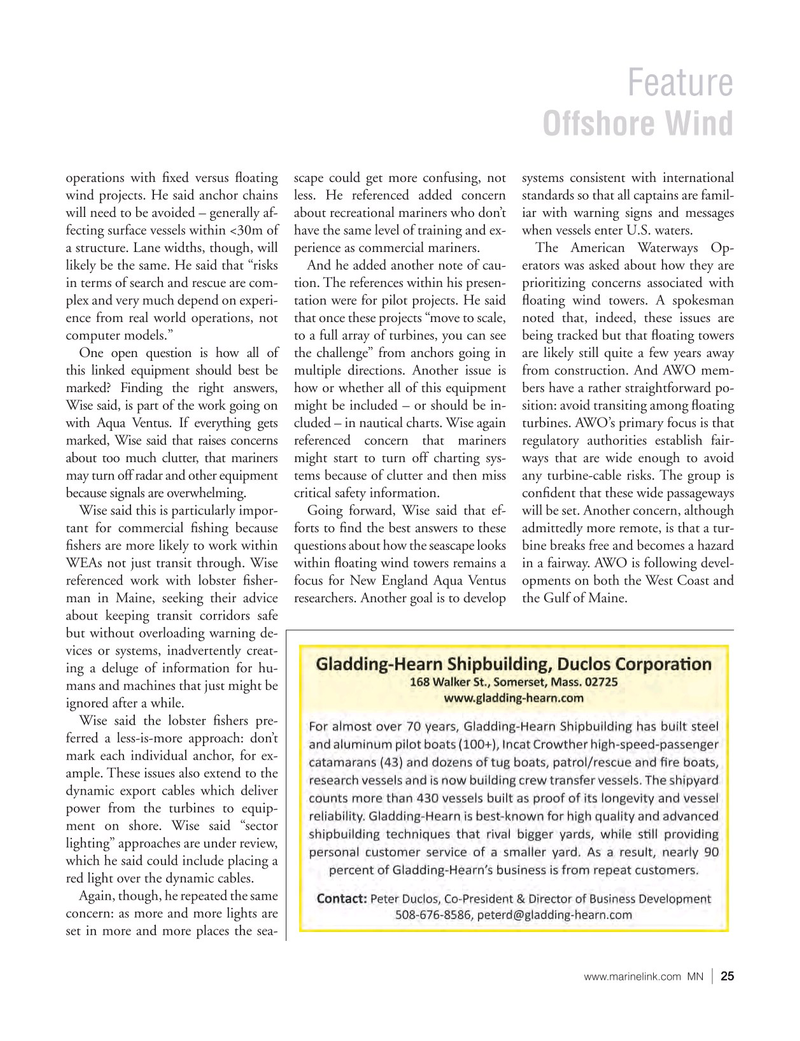
Page 25: of Marine News Magazine (April 2023)
Towboats, Tugs & Barges
Read this page in Pdf, Flash or Html5 edition of April 2023 Marine News Magazine
Feature
Offshore Wind operations with ? xed versus ? oating scape could get more confusing, not systems consistent with international wind projects. He said anchor chains less. He referenced added concern standards so that all captains are famil- will need to be avoided – generally af- about recreational mariners who don’t iar with warning signs and messages fecting surface vessels within <30m of have the same level of training and ex- when vessels enter U.S. waters.
a structure. Lane widths, though, will perience as commercial mariners. The American Waterways Op- likely be the same. He said that “risks And he added another note of cau- erators was asked about how they are in terms of search and rescue are com- tion. The references within his presen- prioritizing concerns associated with plex and very much depend on experi- tation were for pilot projects. He said ? oating wind towers. A spokesman ence from real world operations, not that once these projects “move to scale, noted that, indeed, these issues are computer models.” to a full array of turbines, you can see being tracked but that ? oating towers
One open question is how all of the challenge” from anchors going in are likely still quite a few years away this linked equipment should best be multiple directions. Another issue is from construction. And AWO mem- marked? Finding the right answers, how or whether all of this equipment bers have a rather straightforward po-
Wise said, is part of the work going on might be included – or should be in- sition: avoid transiting among ? oating with Aqua Ventus. If everything gets cluded – in nautical charts. Wise again turbines. AWO’s primary focus is that marked, Wise said that raises concerns referenced concern that mariners regulatory authorities establish fair- about too much clutter, that mariners might start to turn off charting sys- ways that are wide enough to avoid may turn off radar and other equipment tems because of clutter and then miss any turbine-cable risks. The group is because signals are overwhelming. critical safety information. con? dent that these wide passageways
Wise said this is particularly impor- Going forward, Wise said that ef- will be set. Another concern, although tant for commercial ? shing because forts to ? nd the best answers to these admittedly more remote, is that a tur- ? shers are more likely to work within questions about how the seascape looks bine breaks free and becomes a hazard
WEAs not just transit through. Wise within ? oating wind towers remains a in a fairway. AWO is following devel- referenced work with lobster ? sher- focus for New England Aqua Ventus opments on both the West Coast and man in Maine, seeking their advice researchers. Another goal is to develop the Gulf of Maine.
about keeping transit corridors safe but without overloading warning de- vices or systems, inadvertently creat- ing a deluge of information for hu- mans and machines that just might be ignored after a while.
Wise said the lobster ? shers pre- ferred a less-is-more approach: don’t mark each individual anchor, for ex- ample. These issues also extend to the dynamic export cables which deliver power from the turbines to equip- ment on shore. Wise said “sector lighting” approaches are under review, which he said could include placing a red light over the dynamic cables.
Again, though, he repeated the same concern: as more and more lights are set in more and more places the sea- www.marinelink.com MN 25|

 24
24

 26
26
